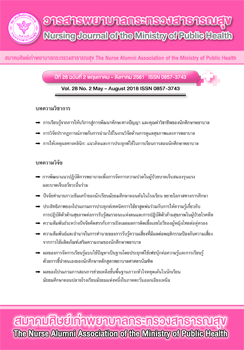Effects of First Aid to Sudden Cardiac Arrest Program for High-school Students in Northeast Thailand.
Main Article Content
Abstract
Abstract
The aim of this study was to examine the effects of first aid to sudden cardiac arrest program on the knowledge and skills of high-school students. The conceptual model guiding this study was derived from the Chain of Survival concept and Theory of instructional design. The sample consisted of 30 high-school students in northeastern Thailand, using a one group pretest –
posttest design. The instruments used were self-administered questionnaires, pretest and posttest, performance appraisals of CPR skill, and a set of training materials developed by researchers. The study was conducted between August and September 2016.
The results showed that the knowledge and skill before receiving intervention were significantly different to those of after receiving the intervention at the .05 level. The findings suggest that this experimental program should be expanded to other school students. However, the study should be re-conducted in a greater number of sample in order to be able to generalize to the population.
Article Details
บทความและรายงานวิจัยในวารสารพยาบาลกระทรวงสาธารณสุข เป็นความคิดเห็นของ ผู้เขียน มิใช่ของคณะผู้จัดทำ และมิใช่ความรับผิดชอบของสมาคมศิษย์เก่าพยาบาลกระทรวงสาธารณสุข ซึ่งสามารถนำไปอ้างอิงได้
References
1. Cardiopulmonary resuscitation Unit Srinagarind Hospital. Basic life support. [N.p.: n.p.]; 2006.
2. American Heart Association. Heart and Stroke statistic update [online] 2015 [cited 2016 January 20]. Available from: http://circ.ahajournals.org/content/early /2014/12/18/CIR.0000000000000152
3. Department of Disease Control, Ministry of Public Health. Data of Non-Communicable diseases [online] 2015 [cited 2016 January 20]. Available from http://www.thaincd.com/information-statistic/non-communicable-disease-data.php?pn=1
4. American Heart Association. 2015 AHA Guidelines update for CPR and ECC [online] 2015 [cited 2016 January 2]. Available from: http://www.cercp.org/images/stories/recursos/Guias%202015/Guide lines-RCP-AHA-2015-Full.pdf
5. Daya MR, Schmicker, RH, Zive, DM, Rea TD, Nichol G, Buick JE, et al. Out-of-hospital cardiac arrest survival improving over time: Results from the Resuscitation Outcomes Consortium (ROC). Resuscitation 2015;91:108-15.
6. Tippayanate N, Chanabuthr W, Thornsao C, Chaiprom K. Capacity building for CPR skill in Mahasarakham Public High Schools, the Northeastern of Thailand . Perspective in multidisciplinary research & Practice in Health science 2016. [Proceeding]. Chiangrai: Mae Fah Luang university; 2016. (in Thai).
7. Partiprajak S. Relation between knowledge, self-efficacy in basic life support skill, and chest compression performance in Thai undergraduate nursing student. Songklanagarind journal of nursing 2015;35(1):115-34. (in Thai).
8. Bo Z. Effect of basic life support program on cardiopulmonary resuscitation knowledge and performance among nurses [Master thesis]. Chiang Mai: Chiang Mai University; 1999.
9. Connolly M, Toner, P, Connolly D, McCluskey RD. The ABC for life program–Teaching basic life support in school. Resuscitation 2007;72:270-79.
10. Isbye DL, Rasmussen LS, Lippert FK, Rudolph SF, Ringsted. CV. Laypersons may learn basic life support in 24 min using a personal resuscitation manikin. Resuscitation 2006;69:453-442;2006.
11. Lynch B, Einspruch EL, Nichol G, Becker LB, Aufderheide, TP, Idris A. Effectiveness of a 30-minutes CPR self-instruction program for lay responder: a controlled randomized study. Resuscitation 2005;67:31-43.
12. Reder. S, Cummings. P, Quan. L. Comparison of three instructional methods for teaching cardiopulmonary resuscitation and use of an automatic external drfibrillator to high school students. Resuscitation 2006;69:443–53.
13. Roppolo. LP, Heymann. R, Pepe. P, Wagner. J, Commons. B, Miller. R, et al. A randomized controlled trialcomparing traditional in cardiopulmonary resuscitation (CPR) to self-directed CPR learning in first year medical students: The two-person CPR study. Resuscitation 2011;82:319–25.
14. Sarac. L, Ok. A. The effect of different instructional methods on students’ acquisition and retention of cardiopulmonary resuscitation skills. Resuscitation 81 2010;81:555-61.
15. Toner. P, Connolly. M, Laverty. L. McGrath, P., Connolly, D., McCluskey, RD. Teaching basic life support to school children using medical students and teachers in a peer-training model–Results of the ABC for life program. Resuscitation 2005;75:169-75.
16. Podhisita C. What happen about “Thai family”?. [online] 2009 [cited 2016 February 23 ]. Available from http://www.ipsr.mahidol.ac.th/IPSR/Annual Conference/ ConferenceV/Download/Article_Files/Article_Intro.pdf .(in Thai).
17. Gagne. MR, Briggs. JL. Principles of instructional design. 2nd edition. New York: Holt, Rinehart and Winston; 1979.
18. Schiesselman. JJ. Planning a longitudinal study I: Sample size determination. J Chron 1973:34-65.
19. Ekkakul T. Research methodology in behavioral sciences and social sciences. 4th edition. Ubonratchathani: Off Set printing house; 2006. (in Thai).
20. Srisatidnarakul B. Development and validation of research instruments: psychometric properties. Bangkok: Chulalongkorn University printing house; 2012. (in Thai).
21. Lovell. BR. Adult learning. New York: John Wiley & Sons, Inc; 1980.
22. Nakpetch K, Apaijirarat J, Yaisum S. Developmental psychology for nurse. 2nd edition. Bangkok: Supa printing house; 2005. (in Thai).
23. Chan-em S. Developmental psychology. 3rd edition. Bangkok: Thai Watana Panich; 1993. (in Thai).
24. Chaisongmuang P. Effectiveness of basic first aid to sudden cardiac arrest program on knowledge and skill among high-school students in provincial secondary school in the northeast [Master thesis]. Khon Kaen: Khon Kaen University; 2017. (in Thai).
